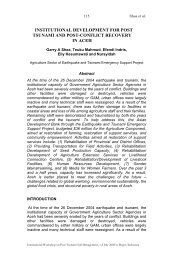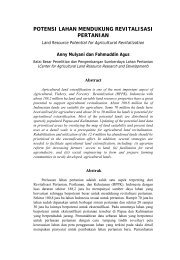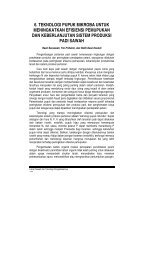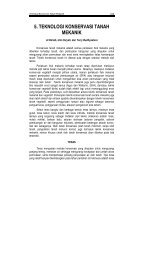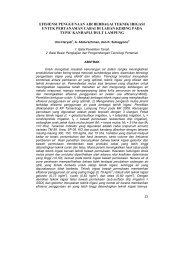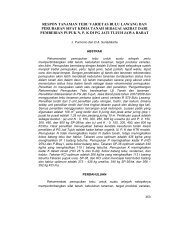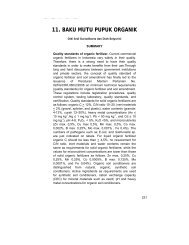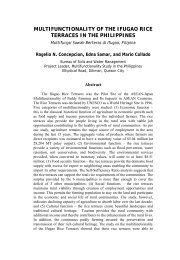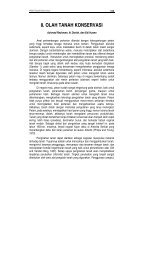Proceedings - Balai Penelitian Tanah
Proceedings - Balai Penelitian Tanah
Proceedings - Balai Penelitian Tanah
Create successful ePaper yourself
Turn your PDF publications into a flip-book with our unique Google optimized e-Paper software.
International Workshop on Post Tsunami Soil Management, 1-2 July 2008 in Bogor, Indonesia<br />
70<br />
Agus F<br />
places the primary drainage canal could be a couple of meter deep<br />
while the field tertiary canal is about 60 cm. However, systematic long<br />
terms data for the relationship of drainage depth and emission rate<br />
are lacking to verify the drainage depth and emission rate relationship<br />
as suggested by Hooijer et al. (2006).<br />
Rice paddy and rubber plantation systems require rather shallow<br />
drainage and accordingly lead to the lowest emissions. However rice<br />
yield on peat soil is usually low and unsustainable due to various<br />
nutrient deficiency and toxicity problems.<br />
PEAT SUBSIDENCE<br />
Peat subsidence occurs through two processes: compaction or<br />
shrinkage and the mass loss due to oxidation (peat decomposition<br />
and burning). Peat compaction occurs very rapidly immediately after<br />
the drainage canal is constructed and, after a few years of drainage, it<br />
stabilizes to two to 4.6 cm annually, depending on the drainage depth<br />
(Wösten, 1997). Peat oxidation depends on the rate of peat burning<br />
and peat decomposition. Figure 2 presents the result of sample<br />
calculation of subsidence due to oxidation. The sum of subsidence<br />
from compaction and oxidation could be around 2 m in 25 years under<br />
oil palm plantation and shallower for other land uses with shallower<br />
drainage. A two meter subsidence translates to about 1.8 m loss of<br />
the peat water retention capacity, causing the surrounding areas<br />
susceptible to floods in the rainy season and to droughts in the dry<br />
season.<br />
eat<br />
sidence<br />
associated<br />
with<br />
p<br />
oxidation (cm/25 yr)<br />
ub<br />
S<br />
120<br />
100<br />
80<br />
60<br />
40<br />
20<br />
0<br />
Maize/vegetable Paddy rice Rubber Oil palm<br />
Land use<br />
Figure 2. Estimated peat subsidence in 25 year period due to peat<br />
decomposition and peat burning. Additional subsidence due<br />
to compaction could be as high as 50 to 100 cm in 25 years



